I regard this article as a supplement to my book, Śrīla Prabhupāda: Founder-Ācārya of ISKCON. It expands upon discussions relating the importance of the Temple of the Vedic Planetarium, especially in light of the philosophical and spiritual significance of Śrīla Bhaktisiddhānta Sarasvatī Ṭhākura’s parent temple, Śrī Caitanya Maṭha, in Māyāpur.
As I write, the resplendent Temple of the Vedic Planetarium, its central dome now towering 350 feet above the alluvial soil of Śrīdhāma Māyāpur, continues to reveal its form, within and without. This temple, when complete, will realize a key component of the International Society for Krishna Consciousness, vital to the fulfillment of the mission of its Founder-Ācārya: to construct Lord Caitanya’s saṅkīrtana movement as the efficacious vessel for delivering humanity worldwide from the rising floods of the spiritual, mental, and physical calamities of our times.
By this undertaking, Śrīla Prabhupāda continued his revival of the interrupted mission of his Guru Mahārāja, and he has left us with all directions and facilities to complete it. Through us, Śrīla Prabhupāda continues his work. The temple taking shape at Māyāpur is central to that task.
We know that the intention to establish the spiritual center for the entire movement at Māyāpur inspired Śrīla Prabhupāda when, in 1972, he celebrated Gaura-pūrṇimā by ceremoniously inaugurating this temple—descending below ground to ritually install its cornerstone. On the previous day he had written to his London disciple Caturbhuja dāsa:
Now I am pleased that you are making serious study of our Krsna philosophy, so I want that you go on like this until you will able to defeat any challenge from atheists and rascals. Then your preaching work will have real potency and combinedly with your God-brothers around the world and at the London temple you shall preach so strongly that one day this Krsna consciousness movement will change the world from the most dangerous condition. That is the wish of Lord Caitanya Mahaprabhu, and tomorrow we shall be celebrating the Lord’s Appearance Day by laying down the corner-stone for our World Headquarters here at Mayapur.
Having committed ourselves to what Śrīla Prabhupāda committed himself to in 1972, we now strive to complete the Temple of the Vedic Planetarium, the ultimate home of the present Śrī Māyāpur Candrodaya Mandīra. When the golden cakra— signifying the all-pervading power of the Lord—will be ceremoniously established and placed upon the gleaming kalaśa at the pinnacle of the temple, the whole edifice itself will be revealed as the very cakra, the hub and apex, of world-wide ISKCON, that victorious, world-spanning deliverer of the mercy of the Rising Moon of Māyāpur. All other far-flung temples and centers and gathering places of the entire International Society for Krishna Consciousness will be knit together as this central temple’s aṁśas and kalās—its incorporated expansions and sub-expansions—as parts, branches, and limbs of itself.
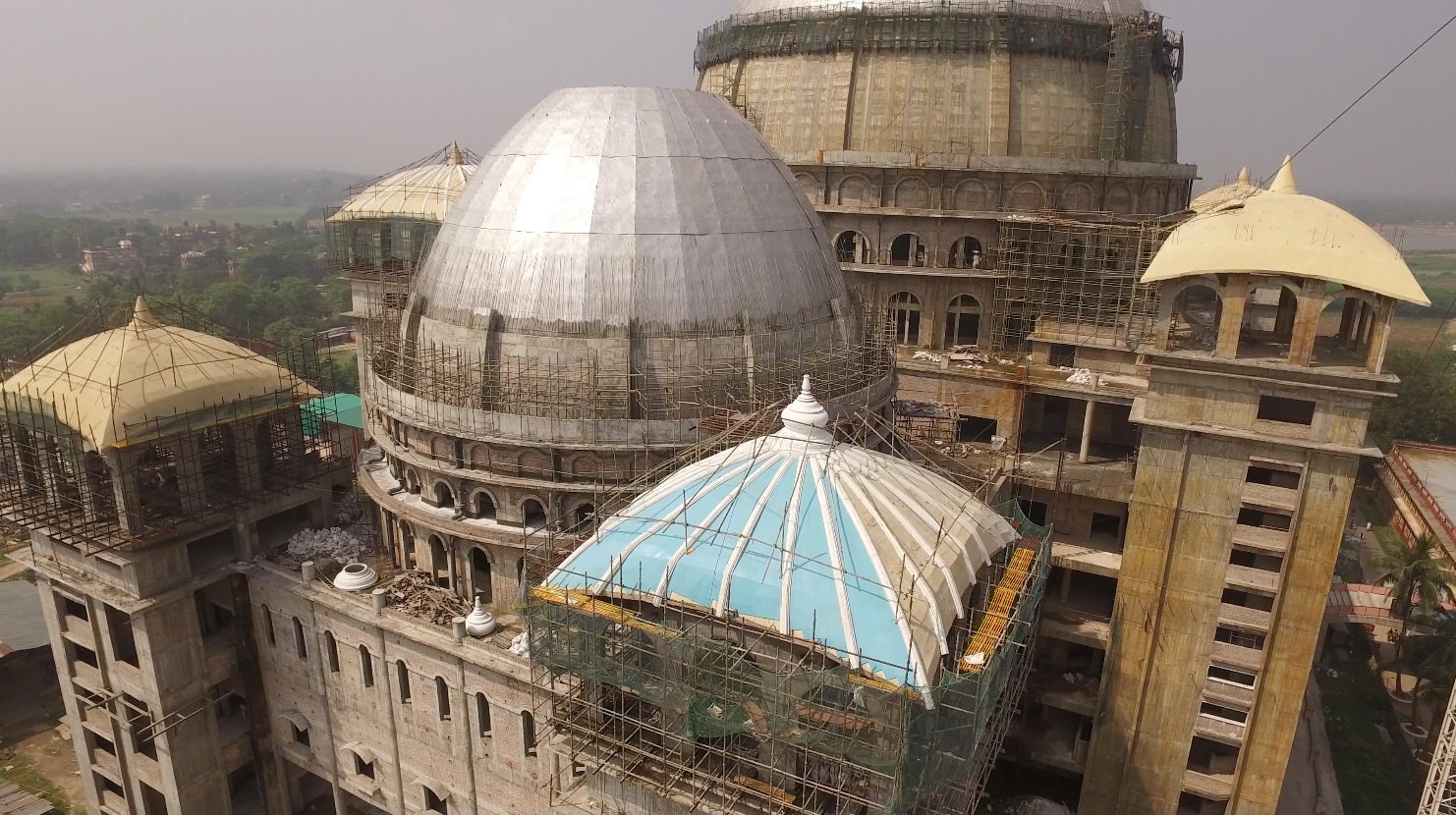 In order to complete this temple, ISKCON itself will have to act as a unified whole, exemplifying that unity in diversity which lies at the heart of Lord Caitanya’s teaching. We may take this as the test of the Founder-Ācārya: “Your love for me,” Śrīla Prabhupāda said in his final months, “will be shown by how much you cooperate to keep this institution together after I am gone.”
In order to complete this temple, ISKCON itself will have to act as a unified whole, exemplifying that unity in diversity which lies at the heart of Lord Caitanya’s teaching. We may take this as the test of the Founder-Ācārya: “Your love for me,” Śrīla Prabhupāda said in his final months, “will be shown by how much you cooperate to keep this institution together after I am gone.”
To aid us in passing this test, we should try to appreciate the temple both for where it is and forwhat it is. Each of these aspects is full of deep spiritual significance as regards the structure and the function of Śrīla Prabhupāda’s mission.
We can think of the temple placed here as a spectacular three-dimensional maṇḍala or yantra, as both a model and a symbol of ultimate reality, taking care to not minimize this maṇḍala as a “mere” symbol: when dealing with the absolute truth, the symbol and the symbolized are non-different. Those who are qualified can directly perceive, for example, that the Lord and His divine names or images are the same. The temple is similarly potent and filled with spiritual power: Śrī Māyāpur Candrodaya Mandīra is the manifest form and emblem of the spiritual dynamo driving the universal saṅkīrtana movement of Lord Caitanya.
THE HEART OF A GLOBAL MOVEMENT
In the sixteenth century, Śrīla Vṛndāvana dāsa Ṭhākura, divine author of the first great biography of Lord Caitanya, set down the future as if it were present to him: “By the mercy of Lord Nityānanda,” he wrote in Śrī Caitanya-bhāgavata, “the entire world is now singing the glories of Lord Caitanya.”
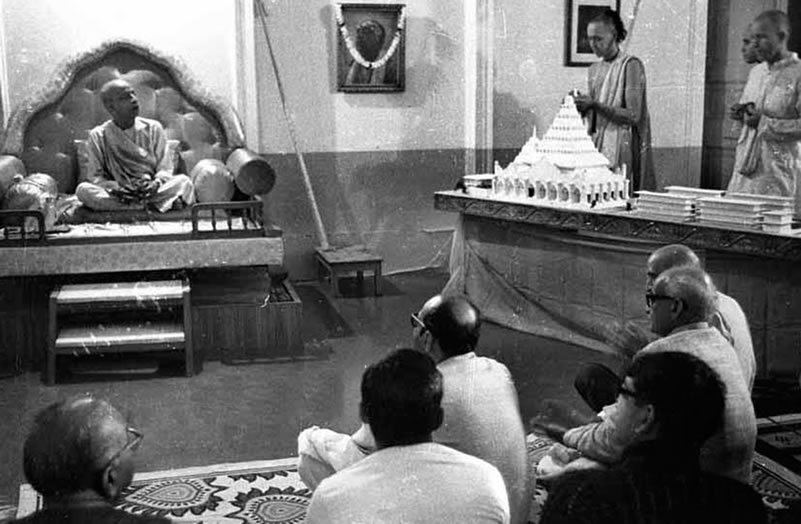 Some three centuries later, Śrīla Prabhupāda sat before his disciples in Māyāpur outlining his plan for erecting a great thirty-story temple there, displaying within it the form and contents of all worlds, both material and spiritual.
Some three centuries later, Śrīla Prabhupāda sat before his disciples in Māyāpur outlining his plan for erecting a great thirty-story temple there, displaying within it the form and contents of all worlds, both material and spiritual.
In short, all that there is: Kŗșṇa and Kŗșṇa’s multifarious energies.
Śrīla Prabhupāda said: “I have named this temple Śrī Māyāpur Candrodaya Mandīra, the Rising Moon of Māyāpur. Now,” he enjoined his followers, “make it rise, bigger and bigger, until it becomes the full moon. And this moonshine will be spread all over the world. All over India they will come to see. From all over the world they will come.”
Two years later in Māyāpur, Śrīla Prabhupāda disclosed the text that had inspired his name for the temple—a phrase found in the first verse of Lord Caitanya’s Śikṣāṣṭaka: śreyaḥ-kairava-candrikā-vitaraṇam. Mahāprabhu’s beautiful metaphor here likens saṅkīrtana to the rays of the moon (candrikā) that open the perfumed blossoms of the night-blooming lily (kairava) of our topmost good (śreyas)—that is, our eternal relationship with Lord Kŗșṇa.
“The ultimate benefit of life is compared with the moon,” Śrīla Prabhupāda said in a Śrīmad-Bhāgavatam class. “So spreading Kŗșṇa consciousness means spreading the moonlight. Therefore we have named this temple Śrī Māyāpur-candrodaya.” The rising (udaya) moon (candra) of Śrī Māyāpur: the name given by Śrīla Prabhupāda intimates that the influence of this temple will come to pervade the entire world.
Moreover, “Caitanya-candra” and “Māyāpur-candra” are both names of Lord Caitanya. So “Śrī Māyāpur-candrodaya” denotes the temple as well as Lord Śrī Caitanya Himself, who presides in His five features as the Pañca-tattva on the temple’s central altar. With these and many other elements and components, the great temple becomes the spiritually energetic and energizing center or dynamo from which the blessings of Lord Caitanya become dispersed throughout the world.
Accordingly, “Within our movement,” Śrīla Prabhupāda told his secretary Brahmānanda Swami, “Māyāpur temple is the first.”
PREDECESSORS OF ISKCON AND ITS
TEMPLE OF THE VEDIC PLANETARIUM
We find that Śrīla Prabhupāda received the inspiration and direction for his whole movement—including the singular temple located at its heart—from the work and teachings of his own spiritual master, Śrīla Bhaktisiddhānta Sarasvatī Ṭhākura.
A brief look at the accomplishments of Śrīla Sarasvatī Ṭhākura will shed light upon those of his singular servant, the sārasvata deva who took up and completed his spiritual master’s project of establishing Lord Caitanya’s teaching (gaura-vāṇī-pracāriṇa) in the Western lands (pāścātya-deśa), so overwhelmed by varieties of nihilism and impersonalism (nirviśeṣa-śūnyavādi).
In 1918 Śrīla Bhaktisiddhānta Sarasvatī Ṭhākura had inaugurated His preaching organization—“Gauḍīya Maṭha” or “Gauḍīya Mission”—with the establishment of the Śrī Caitanya Maṭha in Māyāpur. Over the following decade and a half that mission grew to include over sixty Maṭhas, temples with ashrams for sannyāsīs and brahmacārīs.
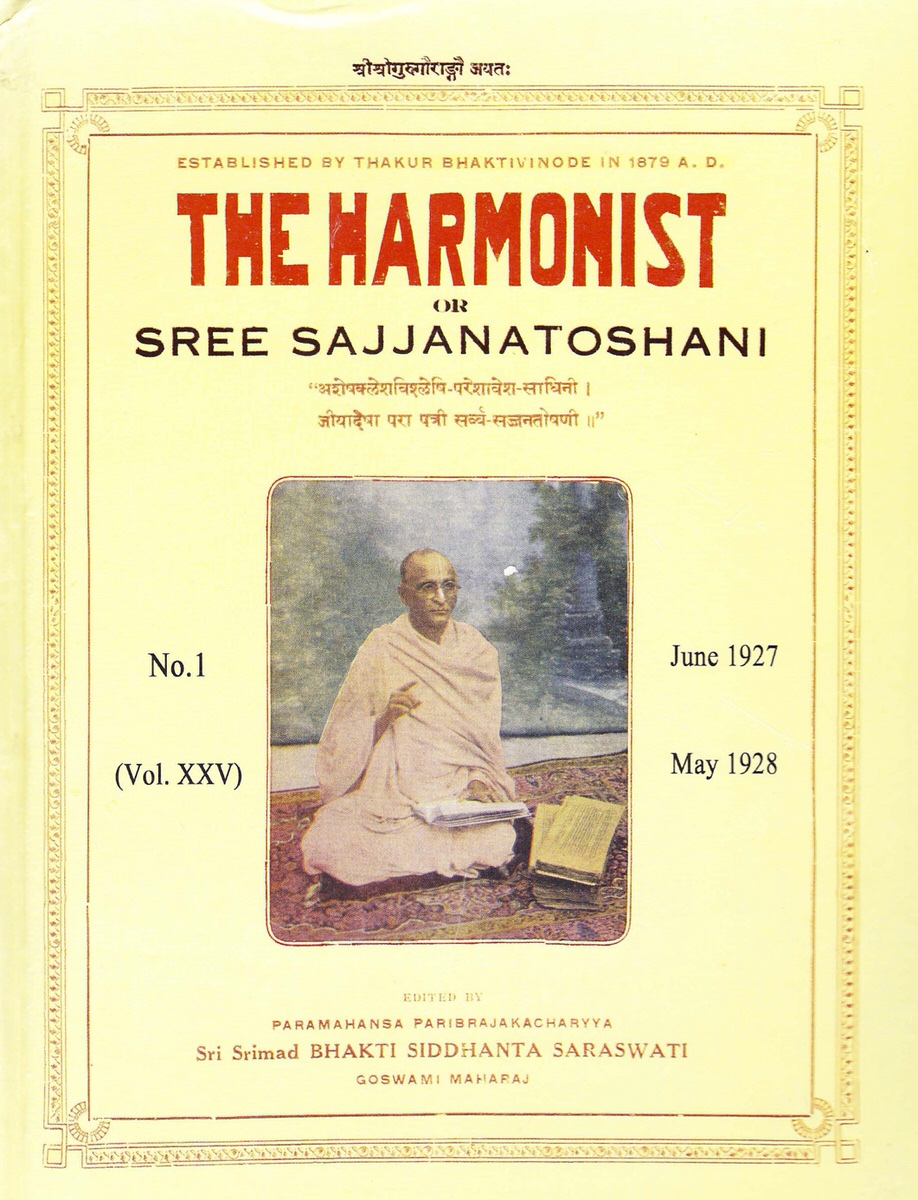 This impressive achievement, however, was only the foundation of his far more audacious project of establishing Lord Caitanya’s movement in the West. Another vital component: in 1927 Śrīla Bhaktisiddhānta Sarasvatī Ṭhākura endowed English-language preaching with eminent status when he transformed one of Śrīla Bhaktivinoda Ṭhākura’s major preaching organs, the Bengali language Sajjana-toṣaṇī, into the English-language journal The Harmonist. Stressing his point, Śrīla Sarasvatī Ṭhākura personally took the position, and title, of Editor. Then three years later, he celebrated the opening of a singularly opulent and imposing temple at Bāg-bazar in Calcutta, designed to serve as his mission’s headquarters for worldwide preaching.
This impressive achievement, however, was only the foundation of his far more audacious project of establishing Lord Caitanya’s movement in the West. Another vital component: in 1927 Śrīla Bhaktisiddhānta Sarasvatī Ṭhākura endowed English-language preaching with eminent status when he transformed one of Śrīla Bhaktivinoda Ṭhākura’s major preaching organs, the Bengali language Sajjana-toṣaṇī, into the English-language journal The Harmonist. Stressing his point, Śrīla Sarasvatī Ṭhākura personally took the position, and title, of Editor. Then three years later, he celebrated the opening of a singularly opulent and imposing temple at Bāg-bazar in Calcutta, designed to serve as his mission’s headquarters for worldwide preaching.
Calcutta was a “world city.” It had served as the imperial seat of the British Raj in the East until 1911. The seat was then transfered to Delhi, yet Calcutta continued on as a vibrant center of commerce, finance, and culture. The city was thus an appropriate location for the headquarters of a global mission, and in 1933 Śrīla Bhaktisiddhānta Sarasvatī Ṭhākura saw off three selected disciples as they embarked for London to preach and establish a temple there.
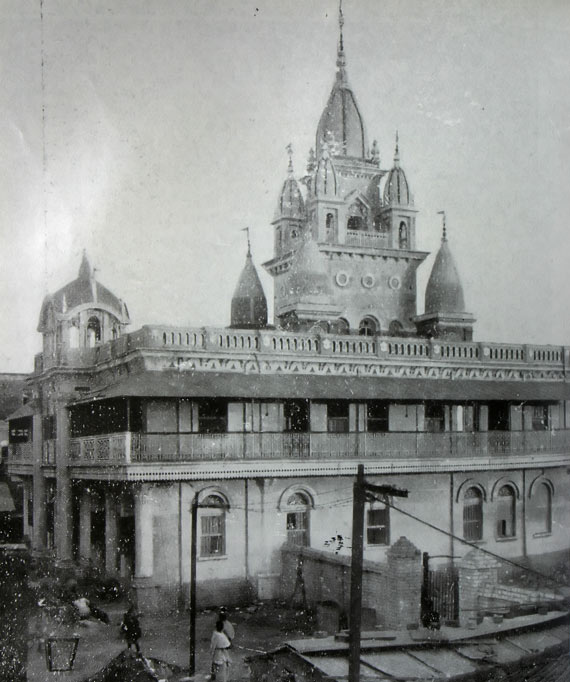 Yet from the beginning of Śrīla Sarasvatī Ṭhākura’s hugely ambitious mission, the unique position of the secluded Māyāpur center had been always recognized and honored. In the movement’s published lists of centers, the Śrī Caitanya Maṭha came first and usually bore the distinctive designation of “Parent Math.” But then, in 1930, the dazzling new Calcutta temple—named as “Sri Gaudiya Matha”—with its prominent location, its facade of pure white marble, its lavish appointments, and its bold mission—seemed to eclipse all other centers, especially the sacrosanct “Parent Temple.” There were seeds, as we now know, of an unhealthy rivalry, a fissure opening in the framework of the movement. The Editor of The Harmonist wanted to counteract that tendency. The temple’s grand opening, accordingly, also occasioned the publication of a rich and detailed explication of the relationship between the conspicuous new center in a great city and its “Parent Temple” hidden somewhere out in the remote Bengali countryside.
Yet from the beginning of Śrīla Sarasvatī Ṭhākura’s hugely ambitious mission, the unique position of the secluded Māyāpur center had been always recognized and honored. In the movement’s published lists of centers, the Śrī Caitanya Maṭha came first and usually bore the distinctive designation of “Parent Math.” But then, in 1930, the dazzling new Calcutta temple—named as “Sri Gaudiya Matha”—with its prominent location, its facade of pure white marble, its lavish appointments, and its bold mission—seemed to eclipse all other centers, especially the sacrosanct “Parent Temple.” There were seeds, as we now know, of an unhealthy rivalry, a fissure opening in the framework of the movement. The Editor of The Harmonist wanted to counteract that tendency. The temple’s grand opening, accordingly, also occasioned the publication of a rich and detailed explication of the relationship between the conspicuous new center in a great city and its “Parent Temple” hidden somewhere out in the remote Bengali countryside.
This long essay turned out to be a profound exposition of the spiritual morphology of the entire institution. Titled “Sri Gaudiya Math,” the article was serialized over three issues of The Harmonist, the movement’s English-language periodical, and was produced under the direct personal supervision of Śrīla Bhaktisiddhānta Sarasvatī Ṭhākura. This three-part essay impressively conveys the theological model of the spiritual institution—the ecclesiology—that guided Śrīla Sarasvatī Ṭhākura and, later, as it would turn out, his most resolute and faithful student Śrīla Bhaktivedanta Swami Prabhupāda as well.
The immediate concern of the article is to elucidate the deep spiritual reasons why the spectacular, newly inaugurated Bāg-bazar temple—“in the modern urban environment,” as the article puts it—is not only subordinate to the Śrī Caitanya Maṭha in Māyāpur, but also is itself an “expansion” of it:
The Gaudiya Math (in Calcutta) is the principle branch of Sri Chaitanya Math of Sridham Mayapur. The distinction between the Gaudiya Math and Sri Chaitanya Math is all analogous to that between one lamp lighted by another. The Gaudiya Math is the expansion of the Chaitanya Math in a visible form into the heart of the world. Sri Chaitanya Math is eternally located as the original source even when it is manifested to the view of the people of this world, in the transcendental environment of the eternal Abode of the Divinity. The activities of the Gaudiya Math and of the other sister branch Maths are, however, essentially identical with those of Sri Chaitanya Math and are categorically different from the ordinary activities of this world.
Here we discover the template upon which Śrīla Prabhupāda faithfully modeled ISKCON’s own spiritual configuration, presented together with the profound—you can say “esoteric”— meaning of it: There is a unique, preeminent “parental” temple situated in Śrīdhāma Māyāpur, “eternally located as the original source,” even as it also “is manifest to the view of the people of this world.” Note that “the original source” is not a reference simply to some relatively recent construction in rural Bengal. Rather, “the original source” of the Gauḍīya Maṭha is “eternally located” in the spiritual realm, that is, “the transcendental environment of the eternal Abode of the Divinity.” That transcendent temple, however, is also made immanent, “manifest to the view of the people of this world.”
Śrīdhāma Māyāpur, the place of Lord Caitanya’s appearance and activities, is simultaneously transcendent and immanent, for, we know that whenever and wherever the Lord descends, His eternal abode and associates all descend with Him. Thus the transcendent realm of Lord Kṛṣṇa’s eternal vṛndāvana-līlā, called Goloka Vṛndāvana, becomes manifest on the earthly plane as Gokula Vṛndāvana. Similarly, the everlasting realm of Lord Caitanya’s līlā in Kṛṣṇaloka, known as Śvetadvīpa, appears in Bengal as the manifest Navadvīpa and its enclosed Śrīdhāma Māyāpur. At these and other such sacred places on earth, the material and spiritual worlds are made, so to speak, contiguous, facilitating crossing over. Hence, the name for such pilgrimage destinations istīrtha, or ford.
This and more, as we shall see, is disclosed, celebrated, and facilitated by the Founder-Ācārya at the “Parent Temple,” which serves at the tīrtha as a visible kind of entrance as of a portal, or gateway, or bridge.
When this central temple, by the mercy of devotees, extends outward from its inherently sacred environment into profane regions, these expansions or branches, even though distant from their source, are essentially identical with it. The analogy of “one lamp lighted by another,” employed by The Harmonist, is taken from Brahma-saṁhitā (5.46), where it is used to elucidate the relationship between Lord Kṛṣṇa and His expansions, like Balarāma, Mahā-viṣṇu, and so on. The use of the metaphor here implies that all the institution’s temples, as integral components of a spiritual organization, will be equally potent, even though one is the original, and the others, its branches or branches of branches.
Having established the essential unity of the original source with its branches and sub-branches, the article goes on to propound the spiritual identity that unifies the Founder-Ācārya with his organization, its various parts and branches, and each of its individual members:
The Gaudiya Math is also identical with its founder Acharyya (sic). The associates, followers and abode of His Divine Grace are limbs of himself. None of them claim to be anything but a fully subordinate limb of this single individual. This unconditional, causeless, spontaneous submission to the Head, is found to be not only compatible with, but also absolutely necessary for the fullest freedom of initiative of the subordinate limbs.
The wholesome spiritual organization, acting with exemplary coherence and concord, is non-different from the Founder-Ācārya. The society is that august, divine personage in another form, the incorporated expansion of his own loving service to Śrī Kṛṣṇa Caitanya. This point is further elucidated:
All activity of the Gaudiya Math emanates from His Divine Grace Paramahansa Srila Bhakti Siddhanta Saraswati Goswami Maharaj, the spiritual successor of Sri Rupa Goswami who was originally authorised by Sri Caitanyadeva to explain the process of loving spiritual devotion for the benefit of all souls. The reality of the whole activity of the Gaudiya Math depends on the initiative of the Acharya. Sri Chaitanya Math of Sridham Mayapur reveals the source of the Gaudiya Math. The Acharya dwells eternally with the Supreme Lord Sri Krishna Chaitanya in His transcendental Abode in Sridham Mayapur, White Island of the Scriptures. From there the Acharya manifests his appearance on the mundane plane for the redemption of souls from the grip of the deluding energy and conferring on them loving devotion to the Feet of Sri Sri Radha-Govinda. The off-shoots of Sri Chaitanya Math are an extension of the centre of the bestowal of grace for the benefit of souls in all parts of the world. The recognition of the connection with Sridham Mayapur is vital for realising the true nature of the Gaudiya Math and the grace of the Acharya.
This passage repays alert reading and reflection. It is a penetrating portrayal of the spiritual structure and function of Śrīla Bhaktisiddhānta Sarasvatī Ṭhākura’s organization. It was written in 1930, yet we can clearly recognize the organization of essential elements of a spiritual institution—the Founder-Ācārya, the central temple of the Ācārya, its disbursed extensions—that is the clear template for ISKCON, founded thirty-five years later by Śrīla Siddhānta Sarasvatī’s fully dedicatedsārasvata disciple, who constructed ISKCON on the basis of a deep and faithful comprehension of his own guru’s works.
Guided by that paradigm, we can recognize the Śrī Caitanya Maṭha of Śrīla Bhaktisiddhānta Sarasvatī Ṭhākura as the prototype, in regard to place, form, and function, of Śrīla Prabhupāda’s Temple of the Vedic Planetarium at Māyāpur. The basis for Śrīla Prabhupāda’s determination to have his movement’s central temple and world headquarters here becomes clear.
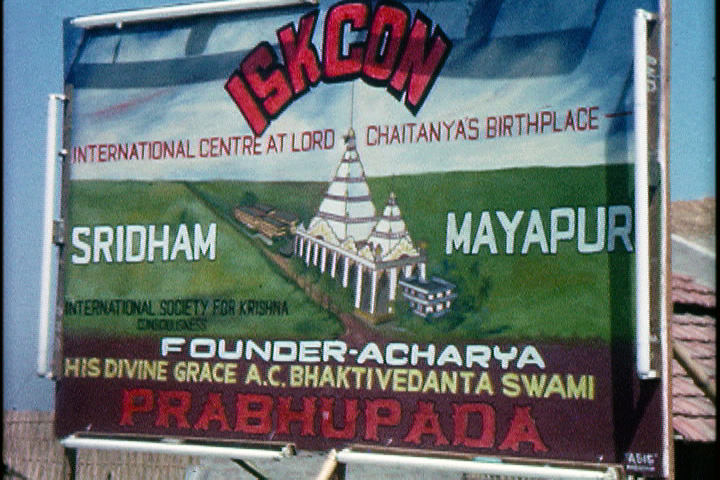 It was at first, to many of us, a great mystery, accepted on faith alone. Most who journeyed to Māyāpur for the first of the annual Gaura-pūrṇimā observances were astounded, upon arrival, to think that Prabhupāda wanted our “world headquarters” here, that here the Governing Body Commission was to hold its annual plenary meeting—here, set down amid cane-fields and rice-paddies stretching to the horizon, here, where we bathed and shaved with icy water in the open air while working the lever of a hand-pump, here where the sparse telephone and electrical facilities were antiquated, haphazard, and hazardous. Was it really and truly here that Śrīla Prabhupāda wanted to establish the heart of ISKCON? “Why not Los Angeles?” some wondered aloud. “Or at least Bombay?” It became yet another test of our faith and of our surrender.
It was at first, to many of us, a great mystery, accepted on faith alone. Most who journeyed to Māyāpur for the first of the annual Gaura-pūrṇimā observances were astounded, upon arrival, to think that Prabhupāda wanted our “world headquarters” here, that here the Governing Body Commission was to hold its annual plenary meeting—here, set down amid cane-fields and rice-paddies stretching to the horizon, here, where we bathed and shaved with icy water in the open air while working the lever of a hand-pump, here where the sparse telephone and electrical facilities were antiquated, haphazard, and hazardous. Was it really and truly here that Śrīla Prabhupāda wanted to establish the heart of ISKCON? “Why not Los Angeles?” some wondered aloud. “Or at least Bombay?” It became yet another test of our faith and of our surrender.
Śrīla Prabhupāda’s conviction that ISKCON’s headquarter temple belongs here testifies to his own faith in and surrender to his spiritual master, whose spiritual vision of the Gauḍīya institution is conveyed by The Harmonist article.
Moreover, since Śrīla Prabhupāda faithfully fabricated ISKCON on the paradigm of Śrīla Bhaktisiddhānta Sarasvatī Ṭhākura’s movement, we can also take advantage of the depiction of that movement in The Harmonist to understand the higher, extraterrestrial region of ISKCON.
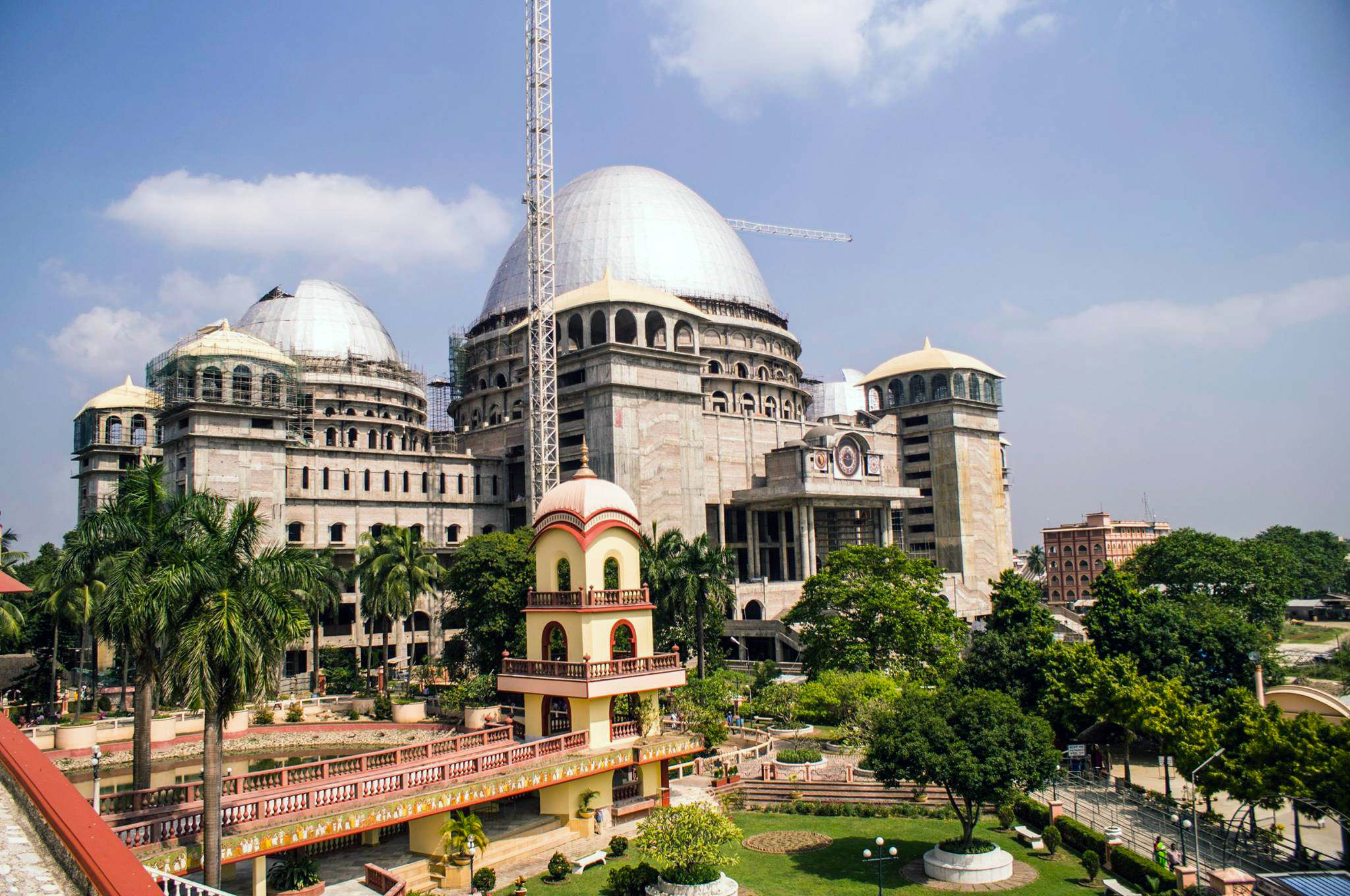 Today at Māyāpur in Bengal anyone can observe the Temple of the Vedic Planetarium and the memorial temple of ISKCON’s Founder-Ācārya—both of them domed structures, as it turned out—facing each other across an open plaza. We should regard this display as the terrestrial manifestation of a transcendent fact: “The Acharya dwells eternally with the Supreme Lord Sri Krishna Chaitanya in His transcendental Abode in Sridham Mayapur, White Island of the Scriptures.” Referring to that place in a letter to a disciple, Tuṣṭa Kṛṣṇa dāsa, Śrīla Prabhupāda wrote: “We will have another ISKCON there.” Andthere, he affirmed in the same letter, the spiritual master and disciple are together forever.
Today at Māyāpur in Bengal anyone can observe the Temple of the Vedic Planetarium and the memorial temple of ISKCON’s Founder-Ācārya—both of them domed structures, as it turned out—facing each other across an open plaza. We should regard this display as the terrestrial manifestation of a transcendent fact: “The Acharya dwells eternally with the Supreme Lord Sri Krishna Chaitanya in His transcendental Abode in Sridham Mayapur, White Island of the Scriptures.” Referring to that place in a letter to a disciple, Tuṣṭa Kṛṣṇa dāsa, Śrīla Prabhupāda wrote: “We will have another ISKCON there.” Andthere, he affirmed in the same letter, the spiritual master and disciple are together forever.
Nor can it be that the ISKCON here and the ISKCON there are disconnected. The Temple of the Vedic Planetarium itself is both the sign and assurance of that connection, between, so to speak, the bhauma and the divya ISKCON. As Founder-Ācārya, Śrīla Prabhupāda leads the ISKCON yatrathere—an everlasting saṅkīrtana-yajña in gaura-līlā—but he is also able to exercise a special providential care for the ISKCON here and even, upon occasion, to depute his associates there to guide, strengthen, and inspire his followers here.
TEMPLES THAT EMBODY AND TEACH PARĀ-VIDYĀ
There is another distinctive feature of Śrīla Bhaktisiddhānta Sarasvatī Ṭhākura’s “Parent Temple” that his faithful sārasvata disciple received, adapted, and developed for his Temple of the Vedic Planetarium. The temple at the heart of ISKCON is fashioned— like its prototype, the Śrī Caitanya Maṭha—not only for the purpose of arcana, divine worship, but also for parā-vidyā, for education in supreme transcendental knowledge as given by Lord Caitanya.
The Śrī Caitanya Maṭha presents this highest knowledge by means of the history of its revelation, its historical unfolding over time. The Temple of The Vedic Planetarium sets forth the same parā-vidyā, but in another way—spatial more than temporal— through depictions of the divine geography and cosmology as disclosed in Śrīmad- Bhāgavatam.
In particular, the Śrī Caitanya Maṭha is designed to proclaim and to celebrate particular, providential, historic acts of Lord Kṛṣṇa, occurring within the 5,000 year- long history of our age, to prepare the way for the advent of Lord Caitanya—who descended in Māyāpur 530 years ago in order to absorb Himself in, and to teach, saṅkīrtana, which is the yuga-dharma, the divine dispensation for this age of Kali.
The appearance of Lord Caitanya had been foretold in the pages of Śrīmad- Bhāgavatam, which records the sage Karabhājana informing King Nimi of the four yuga-avatāras who descend in each age to reveal the yuga-dharma. “In Kali-yuga also,” the sage said,
people worship the Supreme Personality of Godhead by following various regulations of the revealed scriptures. Now kindly hear of this from me. In the age of Kali, intelligent persons perform congregational chanting to worship the incarnation of Godhead who constantly sings the names of Kṛṣṇa. Although His complexion is not blackish, He is Kṛṣṇa Himself. He is accompanied by His associates, servants, weapons and confidential companions.
The Sanskrit word here for weapons is astra, meaning, etymologically, “that which is thrown.” Lord Caitanya’s astra is the Hare Kṛṣṇa Mahā-mantra, a subtle, sonic weapon of immense power, that, when broadcast, spares the life of the ungodly or demonic person, but works to dissolve that person’s godless or demonic mentality. Kali-yuga is so bad, that were all the godless slain, there would be hardly no one left. So Lord Caitanya’s saṅkīrtana is the appropriate process, the yuga-dharma, for our times.
The Śrī Caitanya Maṭha, erected in the birthplace of Lord Caitanya, is designed to make manifest the historical preparation for the advent of this golden-formed avatāra.
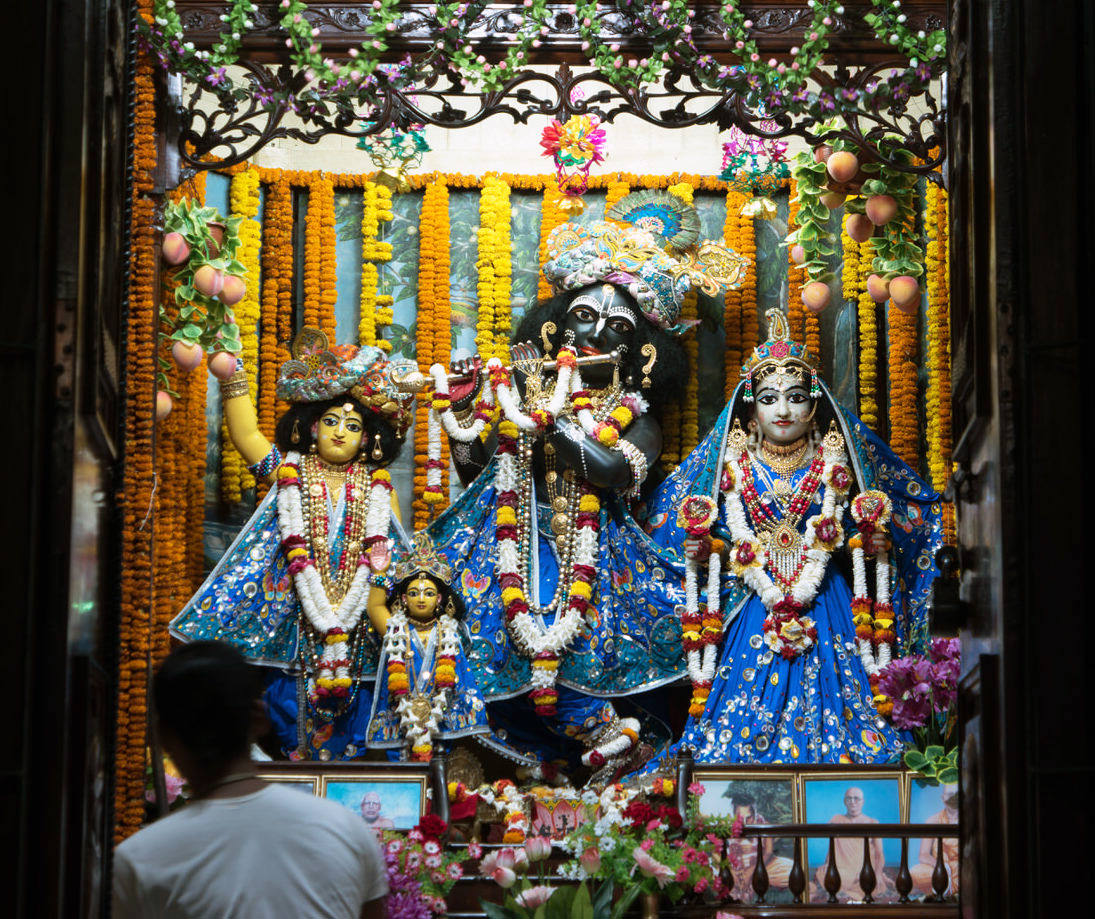 Sheltered under a traditional Bengali parabolic dome are the temple’s three main Deities: The mūrtis of Rādhā-Kṛṣṇa, named “Śrī Śrī Gāndharvikā-Giridhārī,” and, standing right beside Them, the mūrti of Lord Caitanya, named “Śrī Gaurāṅga.” The specific name given Lord Caitanya here—meaning “golden-limbed”—and His close proximity to Rādhā-Kṛṣṇa highlight the significant teaching that Lord Gaurāṅga is Himself a combined form of Rādhā and Kṛṣṇa: He is Kṛṣṇa who has taken on the emotions and bodily hue of Śrīmatī Rādhārāṇī, His own supreme, eternal devotee— the embodiment of His internal spiritual energy of bliss—in order to savor, directly for Himself, Her sublime loving ecstasies.
Sheltered under a traditional Bengali parabolic dome are the temple’s three main Deities: The mūrtis of Rādhā-Kṛṣṇa, named “Śrī Śrī Gāndharvikā-Giridhārī,” and, standing right beside Them, the mūrti of Lord Caitanya, named “Śrī Gaurāṅga.” The specific name given Lord Caitanya here—meaning “golden-limbed”—and His close proximity to Rādhā-Kṛṣṇa highlight the significant teaching that Lord Gaurāṅga is Himself a combined form of Rādhā and Kṛṣṇa: He is Kṛṣṇa who has taken on the emotions and bodily hue of Śrīmatī Rādhārāṇī, His own supreme, eternal devotee— the embodiment of His internal spiritual energy of bliss—in order to savor, directly for Himself, Her sublime loving ecstasies.
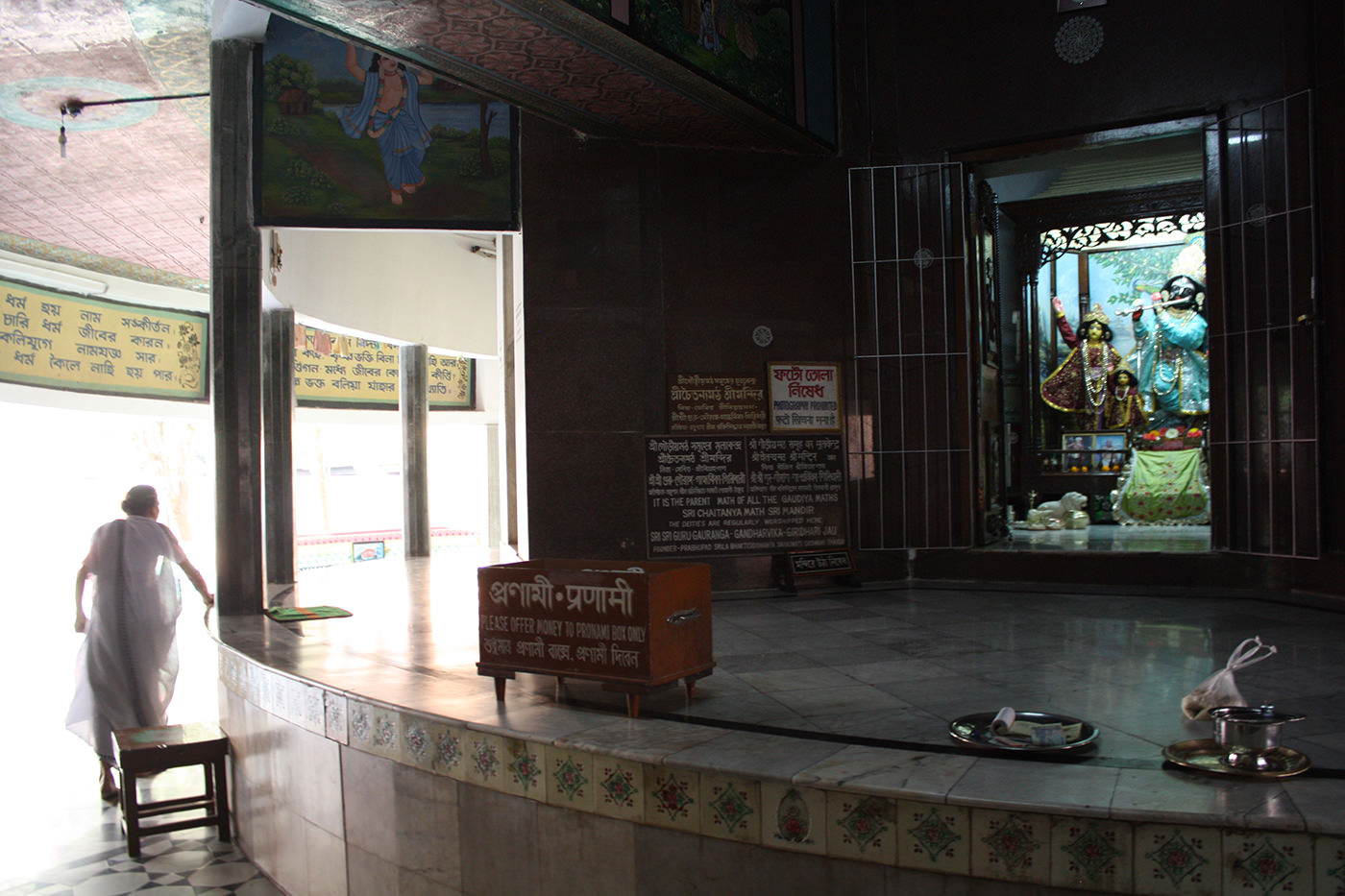 If you circumambulate these three Deities, starting at the main altar and moving clockwise along the circumference of the raised circular base, you will encounter four evenly spaced cubical shrines projecting out from the central dome. Each displays a mūrti of one of the Founder-Ācāryas of the four historical Vaiṣṇava communities, or sampradāyas. Identifying signs flank each shrine—Bengali on the left, English on the right.
If you circumambulate these three Deities, starting at the main altar and moving clockwise along the circumference of the raised circular base, you will encounter four evenly spaced cubical shrines projecting out from the central dome. Each displays a mūrti of one of the Founder-Ācāryas of the four historical Vaiṣṇava communities, or sampradāyas. Identifying signs flank each shrine—Bengali on the left, English on the right.
The English-language sign by the first looks like this:
 Within this shrine you indeed see the formally seated figure of Śrī Madhva, the exemplary teacher or Ācārya—as the sign informs us—of the doctrine (vada) known as śuddha-dvaita, “purified dualism,” the name for Madhvācārya’s signature theistic articulation of Vaiṣṇava Vedānta, inculcating bhakti. If you lean forward a little and peer into the shrine, you will be able to see, within a niche on
Within this shrine you indeed see the formally seated figure of Śrī Madhva, the exemplary teacher or Ācārya—as the sign informs us—of the doctrine (vada) known as śuddha-dvaita, “purified dualism,” the name for Madhvācārya’s signature theistic articulation of Vaiṣṇava Vedānta, inculcating bhakti. If you lean forward a little and peer into the shrine, you will be able to see, within a niche on  the upper left, the form of four-headed Brahmā, the primordial, prehistorical originator of Śrī Madhva’s community, the Brahma-sampradāya. Continuing around the circumference, you will similarly encounter Śrī Viṣṇu Swami, Ācārya of śuddhādvaita (“purified monism”) in the Rudra-sampradāya, with its divine originator Lord Śiva in the niche; then Śrī Nimbārka, Ācārya of dvaitādvaita (“monism and dualism”) in the Kumāra- sampradāya, with the four young sons of Brahmā in the niche; and finally, Śrī Rāmānuja, Ācārya of viśiṣṭādvaita (“qualified monism”) in the Śrī-sampradāya, with Lakṣmīdevī in the niche.
the upper left, the form of four-headed Brahmā, the primordial, prehistorical originator of Śrī Madhva’s community, the Brahma-sampradāya. Continuing around the circumference, you will similarly encounter Śrī Viṣṇu Swami, Ācārya of śuddhādvaita (“purified monism”) in the Rudra-sampradāya, with its divine originator Lord Śiva in the niche; then Śrī Nimbārka, Ācārya of dvaitādvaita (“monism and dualism”) in the Kumāra- sampradāya, with the four young sons of Brahmā in the niche; and finally, Śrī Rāmānuja, Ācārya of viśiṣṭādvaita (“qualified monism”) in the Śrī-sampradāya, with Lakṣmīdevī in the niche.
This symmetrical layout is a great three-dimensional maṇḍala in which the rectangular shrines of the four Founder-Ācāryas converge, spoke-like, upon the hub of the central domed sanctuary of Lord Śrī Caitanya and Śrī-Śrī Rādhā-Kṛṣṇa. It impresses upon the visitor, in a formidable and memorable manner, the central Gauḍīya Vaiṣṇava recognition, both historical and philosophical, of the comprehensiveness, inclusiveness, and supremacy of the ultimate Vedāntic synthesis, acintya-bhedābheda- tattva, promulgated by Śrī Caitanya Mahāprabhu Himself.
The understanding of Vaiṣṇava history that Śrīla Bhaktisiddhānta Sarasvatī Ṭhākura expounded in this tangible way had been received by him through his father, Śrīla Bhaktivinoda Ṭhākura, who, in the late nineteenth century, had commenced the endeavor of propagating Lord Caitanya’s movement globally. In his book Daśa-mula- tattva, Śrīla Bhaktivinoda Ṭhākura summarized his presentation of how Lord Caitanya “purified and perfected” the teachings of the four Founder-Ācāryas:
The previous philosophical expositions of the Absolute Truth based on the Veda by different ācāryas were all incomplete and at variance with each other. As a result, different paramparās, preceptorial chains of disciplic succession, were founded. The Supreme Personality of Godhead, Śrī Caitanya Mahāprabhu, appeared and, by His omniscient potency, synthesised and supplemented the ideas of their philosophies. Śrī Madhvācārya’s concept of the transcendental form of the Supreme Lord—the embodiment of eternality, absolute knowledge and unlimited bliss; Śrī Rāmānuja’s concept of the status of the Supreme Lord’s eternal associates and transcendental energies; Śrī Viṣṇu Svāmī’s concept of purified monism; and Śrī Nimbārka’s concept of eternal simultaneous oneness and duality—all these esoteric concepts were purified and perfected by Śrī Caitanya Mahāprabhu. He gave to this world, by His unlimited mercy, the most exact and scientific delineation of the Vedic conclusion in His teachings of acintya-bhedābheda-tattva, the principle of inconceivable simultaneous oneness and difference. Within a short time, a singular spiritual line—the Śrī Brahma- sampradāya—has gained unexpected pre-eminence [because Lord Caitanya received initiation into it], and all the other sampradāyas, spiritual lines, have become subservient to and will reach perfection by its metaphysical precepts.
In this way, by means of the central maṇḍala of the “Parent Temple,” the entire institution becomes knit together and expressed as an integrated whole, exemplifying as well as teaching the ultimate principle of divinity taught by Lord Caitanya, acintya- bhedābheda-tattva.
TEMPLE OF THE VEDIC PLANETARIUM
Śrīla Prabhupāda had devoted profound and prolonged attention to the words and deeds of his spiritual master, and he had taken to heart his guru’s instructions—given orally at their first meeting and in writing in their last communication—to spread Lord Caitanya’s movement in the English language. He managed singlehandedly the task of translating into English and commenting on the First Canto of Śrīmad- Bhāgavatam, printing and publishing the work in three volumes in India.
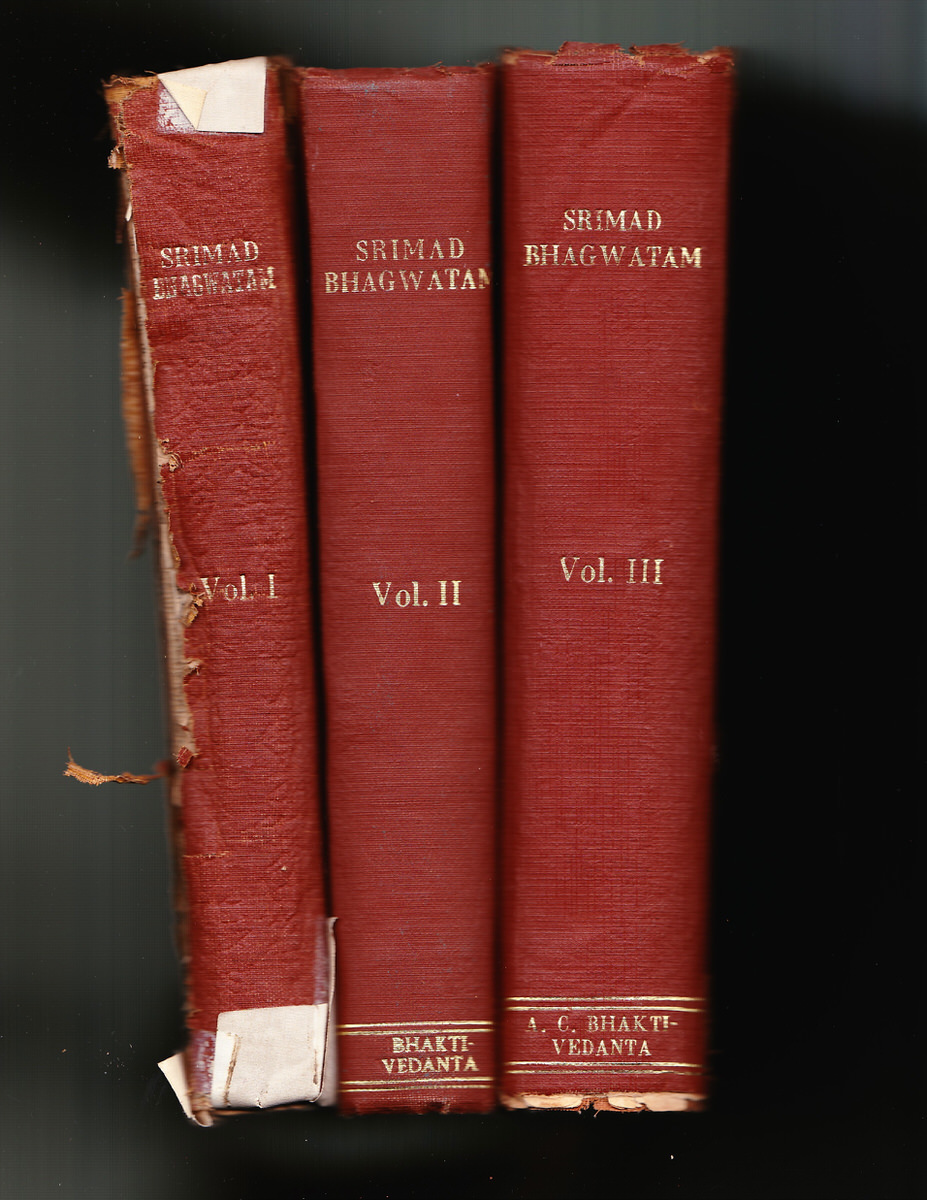 Armed with these books, he sailed for the United States, alone, where in New York City he began to gain dedicated students. Seeing great potential for preaching, he appealed to Godbrothers in India for help and cooperation, but his appeals fell on deaf ears. At the same time, his own guru’s organization remained shattered and in disarray, the sundering having begun along the very fracture that the 1930 Harmonist article had sought to heal. Śrīla Prabhupāda realized that when it came to the revival and continuation of his Guru Mahārāja’s mission, he was on his own. Consequently, in July of 1966 in New York he founded The International Society for Krishna Consciousness.
Armed with these books, he sailed for the United States, alone, where in New York City he began to gain dedicated students. Seeing great potential for preaching, he appealed to Godbrothers in India for help and cooperation, but his appeals fell on deaf ears. At the same time, his own guru’s organization remained shattered and in disarray, the sundering having begun along the very fracture that the 1930 Harmonist article had sought to heal. Śrīla Prabhupāda realized that when it came to the revival and continuation of his Guru Mahārāja’s mission, he was on his own. Consequently, in July of 1966 in New York he founded The International Society for Krishna Consciousness.
As ISKCON quickly blossomed into a world-spanning enterprise, Śrīla Prabhupāda remained guided by his spiritual master’s prior effort. For him, the Gauḍīya Mission served as the prototype or template for ISKCON, which itself became, in effect, the resurrection, augmentation, and perpetuation of Śrīla Bhaktisiddhānta Sarasvatī Ṭhākura’s organization, an organization that served for Śrīla Prabhupāda as a kind of beta-test version of his global movement. In this way, Śrīla Prabhupāda followed in the footsteps of Śrīla Bhaktisiddhānta Sarasvatī Ṭhākura.
It is not surprising to recognize that Śrīla Prabhupāda undertook to construct ISKCON according to the principles spelled out in The Harmonist article of 1930, which disclosed the singular import of the central or “parent” temple at Śrīdhāma Māyāpur, as well as its connection with the Founder-Ācārya. And, as we have seen, that unique temple embodies the most confidential teaching disclosed by Māyāpura- candrodaya—Lord Caitanya—Himself: acintya-bhedābheda-tattva.
Śrīla Prabhupāda chose not to imitate or duplicate the way Śrī Caitanya Maṭha presented the supremacy of acintya-bhedābheda-tattva; rather he chose to augment and expand on that exposition. Just as his world-wide movement itself is an expansion and augmentation of Śrīla Sarasvatī Ṭhākura’s, so, appropriately, will be its headquarter temple.
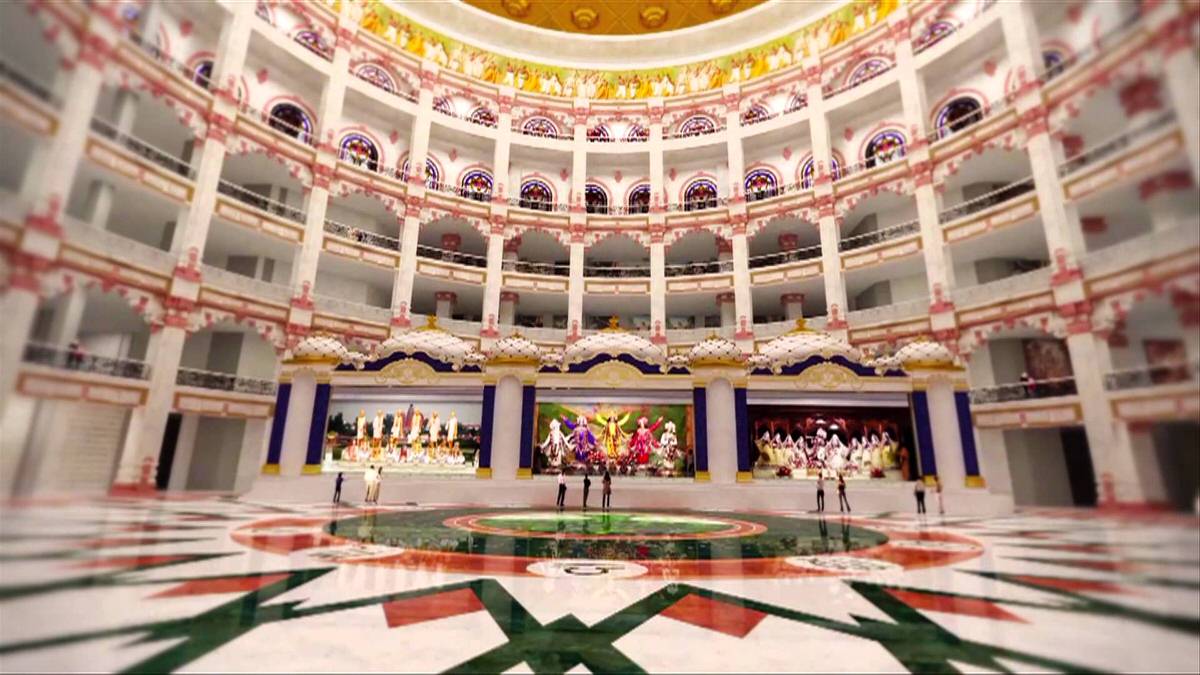 The Deities on the three main altars of the Temple of the Vedic Planetarium, for example, are expansions and elaborations of the Deities at the Śrī Caitanya Maṭha. The Śrī Caitanya Maṭha enshrines Rādhā-Kṛṣṇa; the Temple of the Vedic Planetarium, Rādhā and Kṛṣṇa accompanied by the eight intimate associates of Śrīmatī Rādhārāṇī, the aṣṭa-sakhī-gopīs. The Śrī Caitanya Maṭha worships Lord Gaurāṅga; the Temple of the Vedic Planetarium, the entire Pañca-tattva. The Śrī Caitanya Maṭha hallows the four historical Founder-Ācāryas; the altar in the Temple of the Vedic Planetarium hallows the entire lineage of great Ācāryas in our Brahma-sampradāya.
The Deities on the three main altars of the Temple of the Vedic Planetarium, for example, are expansions and elaborations of the Deities at the Śrī Caitanya Maṭha. The Śrī Caitanya Maṭha enshrines Rādhā-Kṛṣṇa; the Temple of the Vedic Planetarium, Rādhā and Kṛṣṇa accompanied by the eight intimate associates of Śrīmatī Rādhārāṇī, the aṣṭa-sakhī-gopīs. The Śrī Caitanya Maṭha worships Lord Gaurāṅga; the Temple of the Vedic Planetarium, the entire Pañca-tattva. The Śrī Caitanya Maṭha hallows the four historical Founder-Ācāryas; the altar in the Temple of the Vedic Planetarium hallows the entire lineage of great Ācāryas in our Brahma-sampradāya.
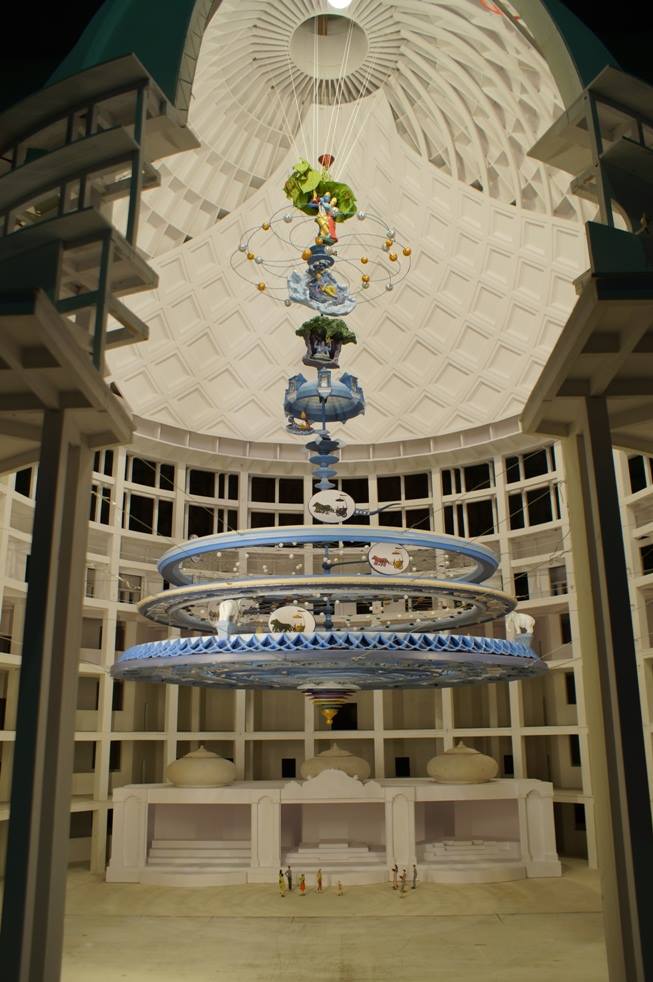 The Temple of the Vedic Planetarium also embodies acintya-bhedābheda-tattva as the ultimate principle of Vedānta, not through the history of teachings, but rather by means of a dynamic representation of the entire inventory of existence, of all that there is: to put it succinctly, Kṛṣṇa and Kṛṣṇa’s energies. This representation hangs, suspended over the main temple room from the apex of the dome “a huge, detailed model of the universe as described in the text of the fifth canto of Srimad Bhagavatam,” as Śrīla Prabhupāda described it in a letter of 1976. He went on to list fifteen numbered features, beginning with Pātāla-loka and the bila-svarga underworld at the base, and ending with Goloka Vṛndāvana at the top. “This model,” Śrīla Prabhupāda further specified, “will be engineered to suspend from the structure of the dome and rotate according to the real movement of the planets.”
The Temple of the Vedic Planetarium also embodies acintya-bhedābheda-tattva as the ultimate principle of Vedānta, not through the history of teachings, but rather by means of a dynamic representation of the entire inventory of existence, of all that there is: to put it succinctly, Kṛṣṇa and Kṛṣṇa’s energies. This representation hangs, suspended over the main temple room from the apex of the dome “a huge, detailed model of the universe as described in the text of the fifth canto of Srimad Bhagavatam,” as Śrīla Prabhupāda described it in a letter of 1976. He went on to list fifteen numbered features, beginning with Pātāla-loka and the bila-svarga underworld at the base, and ending with Goloka Vṛndāvana at the top. “This model,” Śrīla Prabhupāda further specified, “will be engineered to suspend from the structure of the dome and rotate according to the real movement of the planets.”
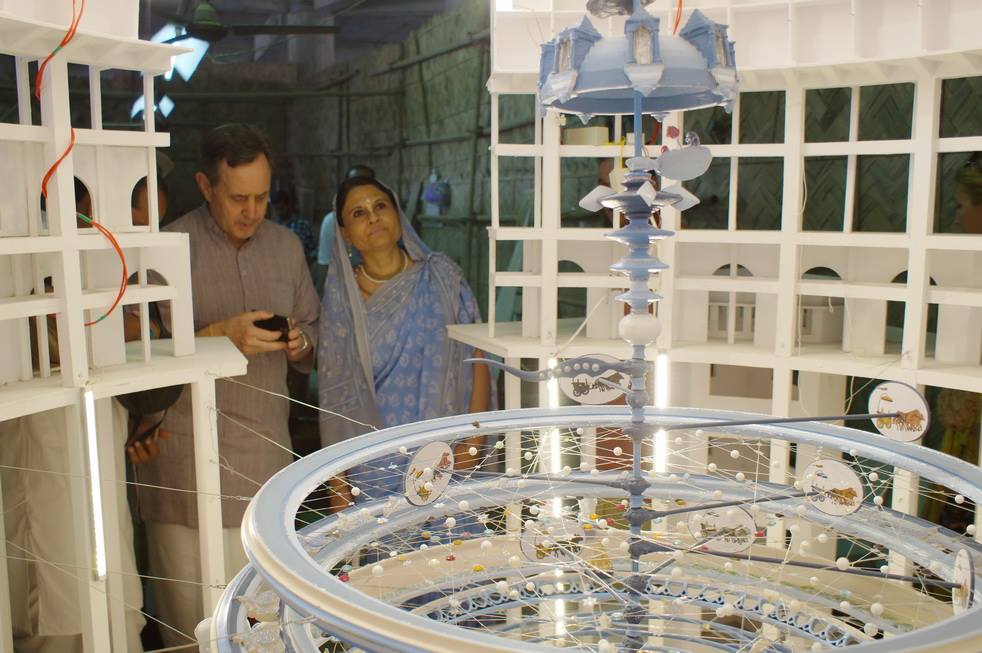 The model—about 140 feet in length and 65 feet in diameter—will, of course, be visible from the main temple-room floor, and visitors will get much closer, detailed views from three levels of open gallery, accessible by escalators, around the inside of the dome. These galleries will also offer additional details and explanations, and the entire cosmology will be further explored and explained in the west, museum wing, of the temple.
The model—about 140 feet in length and 65 feet in diameter—will, of course, be visible from the main temple-room floor, and visitors will get much closer, detailed views from three levels of open gallery, accessible by escalators, around the inside of the dome. These galleries will also offer additional details and explanations, and the entire cosmology will be further explored and explained in the west, museum wing, of the temple.
KṚṢṆA’S UNIVERSAL FORM:
THE COSMOS AS BODY OF GOD
The source of the cosmology in the Temple of the Vedic Planetarium is, as Śrīla Prabhupāda directed, mainly the exposition in The Fifth Canto of Śrīmad-Bhāgavatam.
That begins (5.16.3) with this question by Mahārāja Parīkṣit:
When the mind is fixed upon the Supreme Personality of Godhead in His external feature made of the material modes of nature—the gross universal form—it is brought to the platform of pure goodness. In that transcendental position, one can understand the Supreme Personality of Godhead, Vāsudeva, who in His subtler form is self-effulgent and beyond the modes of nature. O my lord, please describe vividly how that form, which covers the entire universe, is perceived.
SB 5.16.3
Readers or hearers of the Bhāgavatam have been prepared for this Fifth Canto presentation from early on in the work. In the Second and Third Cantos we encounter five separate descriptions of the universal form—the virāṭ-rūpa—of the Lord (in the first, sixth, and tenth chapters of the Second Canto and the sixth and twenty-sixth of the Third). The initial presentation in Canto Two, Chapter One is titled, significantly, “The First Step in God Realization.”
Now in the Fifth Canto the Bhāgavatam returns to and enlarges on this topic of the virāṭ-rūpa; it presents the reader with a directed contemplation of the material world, one that purifies and elevates the consciousness, “brings the mind to the platform of pure goodness.” The conventional way of looking at this world has the opposite effect; it besmirches and degrades the mind. Our customary way of seeing, probing, and appraising the world is undertaken with the aim of enjoying, controlling, and exploiting it and its contents. By so doing we explicitly or implicitly separate the creation from its creator, mentally alienating the world from its true owner and controller. Consequently, the divinity that pervades and hallows the world remains beyond our ken.
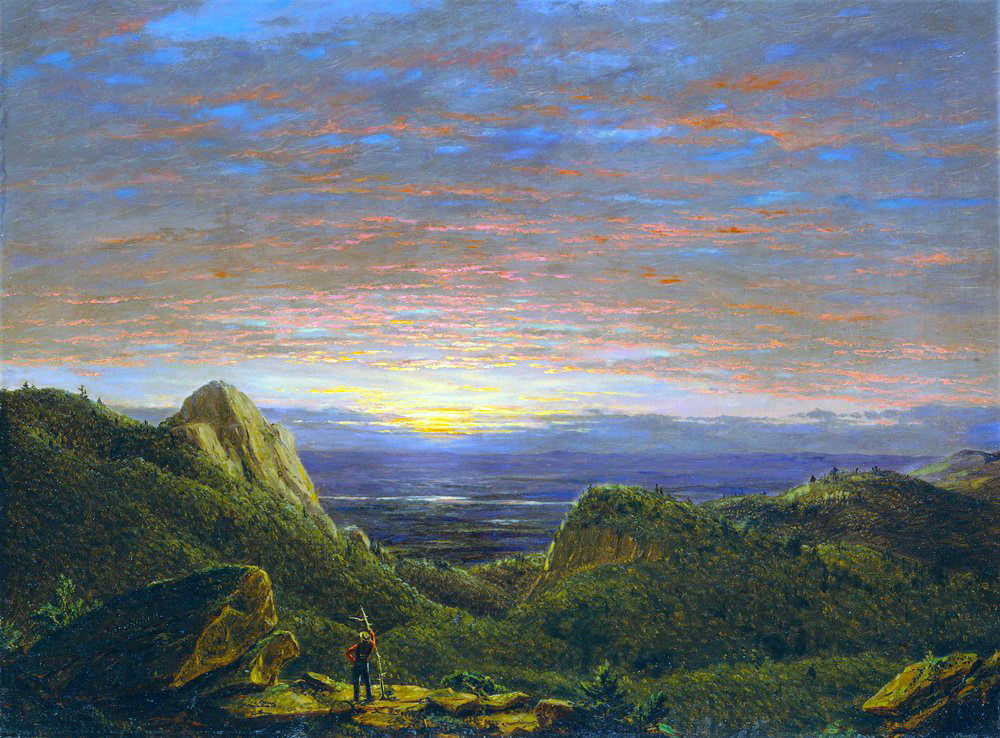 Our materially infected consciousness, corrupted by desire, cannot perceive even this world as it really is, to say nothing of the Lord in His transcendent form. Even so, we do recognize objects that correspond to words like “tree,” “cloud,” “mountain,” “river,” “bird,” and the like, and the Bhāgavatam directs us (in the first chapter of the Second Canto) to see trees as the hair on the Lord’s body, rivers as His veins, mountains as His bones, birdsongs as exhibitions of His artistic taste, and so on.
Our materially infected consciousness, corrupted by desire, cannot perceive even this world as it really is, to say nothing of the Lord in His transcendent form. Even so, we do recognize objects that correspond to words like “tree,” “cloud,” “mountain,” “river,” “bird,” and the like, and the Bhāgavatam directs us (in the first chapter of the Second Canto) to see trees as the hair on the Lord’s body, rivers as His veins, mountains as His bones, birdsongs as exhibitions of His artistic taste, and so on.
Perceiving these natural phenomena as belonging to the Lord’s form begins to cleanse our perception. As consciousness becomes clarified, the presence of divinity in the world becomes self-evident. This perception, articulated as a theology, is called pantheism; from the Śrīmad-Bhāgavatam’s perspective, it is a part—an initial glimpse—of the truth of divinity.
With this we see one of the reasons for prominently featuring the virāṭ-rūpa at the heart of Lord Caitanya’s global movement: offering that “first step” in God realization to all comers.
THE RESPIRITUALIZATION OF MATTER
The other purpose is to put on display a vivid and comprehensive presentation of Lord Caitanya’s Vedāntic synthesis, acintya-bhedābheda-tattva. This principle (tattva) expresses the relationship between Lord Kṛṣṇa and His various energies. It stipulates that you can neither conceive of the creation as identical with Kṛṣṇa, nor can you conceive of it as different from Him.
Śrīla Prabhupāda formulates the principle quite succinctly in his purport to the final verse of Bhagavad-gītā: “Nothing is different from the Supreme, but the Supreme is always different from everything.” He gives another aphoristic formulation in his purport to Caitanya-caritāmṛta Ādi 1.51: “In a sense, there is nothing but Śrī Kṛṣṇa, and yet nothing is Śrī Kṛṣṇa save and except His primeval personality.”
“The universal form is certainly material,” Śrīla Prabhupāda wrote, commenting on Śrīmad-Bhāgavatam 5.16.3, “but because everything is an expansion of the energy of the Supreme Personality of Godhead, ultimately nothing is material.”
He elaborates on this idea in the short book The Path of Perfection:
In a higher sense, there is no matter at all. Everything is spiritual. Because Kṛṣṇa is spiritual and matter is one of the energies of Kṛṣṇa, matter is also spiritual. Kṛṣṇa is totally spiritual, and spirit comes from spirit. However, because the living entities are misusing this energy—that is, using it for something other than Kṛṣṇa’s purposes—it becomes materialized, and so we call it matter. The purpose of this Kṛṣṇa consciousness movement is to respiritualize this energy. It is our purpose to respiritualize the whole world, socially and politically. Of course, this may not be possible, but it is our ideal. At least if we individually take up this respiritualization process, our lives become perfect.
“Respiritualization” is also described in the purport to Bhagavad-gītā 4.24:
The more the activities of the material world are performed in Kṛṣṇa consciousness, or for Viṣṇu only, the more the atmosphere becomes spiritualized by complete absorption ….. The Lord is spiritual, and the rays of His transcendental body are called brahma-jyoti, His spiritual effulgence. Everything that exists is situated in that brahma-jyoti, but when the jyoti is covered by illusion (māyā) or sense gratification, it is called material. This material veil can be removed at once by Kṛṣṇa consciousness; thus the offering for the sake of Kṛṣṇa consciousness, the consuming agent of such an offering or contribution, the process of consumption, the contributor, and the result are—all combined together—Brahman, or the Absolute Truth. The Absolute Truth covered by māyā is called matter. Matter dovetailed for the cause of the Absolute Truth regains its spiritual quality. Kṛṣṇa consciousness is the process of converting the illusory consciousness into Brahman, or the Supreme.
Those who are highly advanced in Kṛṣṇa consciousness perceive this world in relationship to Kṛṣṇa, as pervaded and controlled by the Lord (īśāvāsyam idaṁ sarvam), and the cosmology as described in Śrīmad-Bhāgavatam, and as depicted in the Temple of the Vedic Planetarium, is the record of their direct experience.
Today we also have been given the means by Lord Caitanya to verify that experience by our own. For this reason, Śrīla Prabhupāda has called Kṛṣṇa consciousness “a science.” The science of Kṛṣṇa consciousness is certainly not the same as the relatively recently developed material science, and the cosmos modeled in the Temple of the Vedic Planetarium differs greatly from that as perceived by our limited material senses, whether working unaidedly or augmented and extended by instruments of modern technology. The Temple of the Vedic Planetarium is a challenge to the limitations, defects, and errors of our man-made ways of knowing.
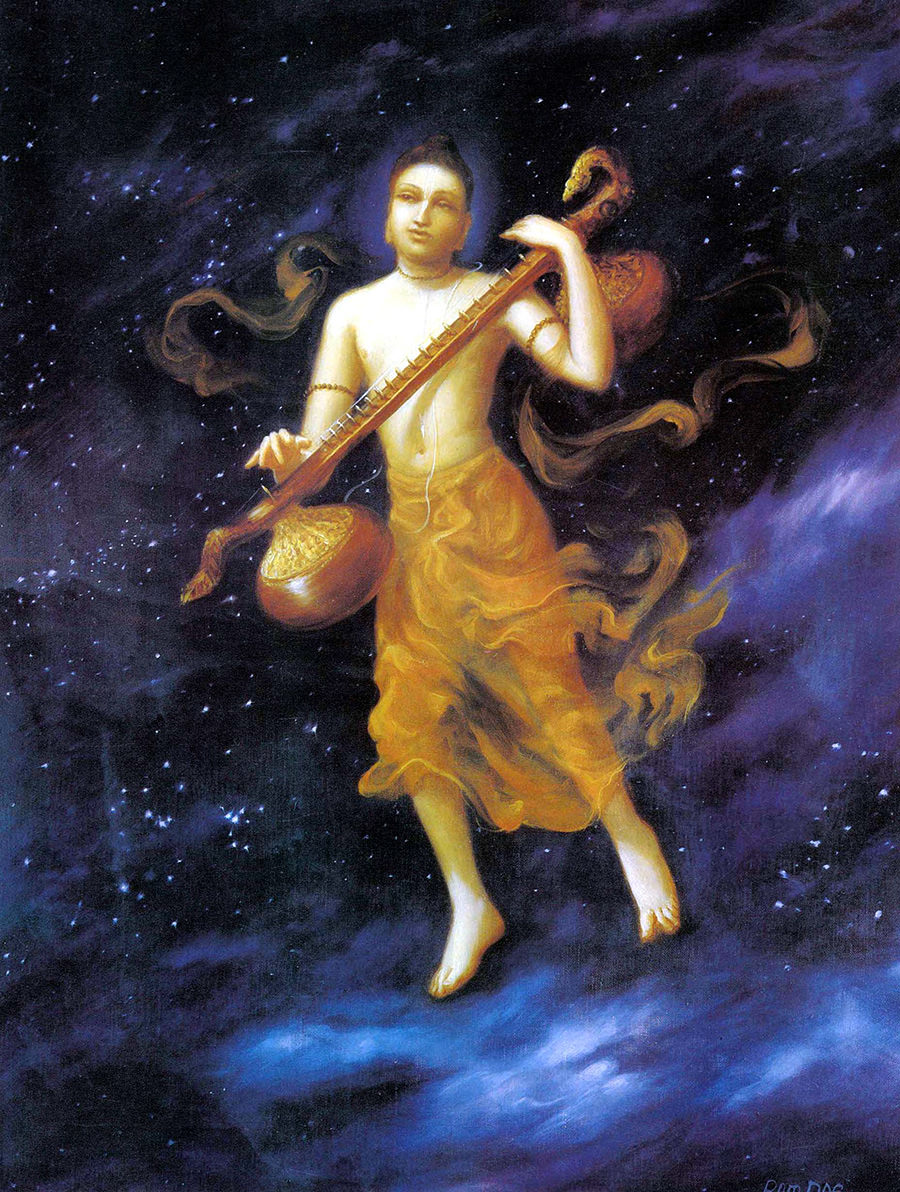 Space travel, for example, is described regularly in the pages of Śrīmad-Bhāgavatam. We find frequent accounts interplanetary travel, most notably the star trekking voyages of the sage Nārada Muni, a great yogi and Vedic cosmonaut; Śrīla Prabhupāda referred to him as “the eternal spaceman.” In fact, the Bhāgavatam presents systematically descriptions of all the greater and lesser yoga-siddhis—science-fiction-like powers such as teleportation, miniaturization, remote viewing, and so on—which in the Bhāgavatam are recognized not as miracles or magic, but rather as jñāna and vijñāna, knowledge and science. But, as the scientist and science-fiction author Arthur C. Clarke observed: “Any sufficiently advanced technology is indistinguishable from magic.”
Space travel, for example, is described regularly in the pages of Śrīmad-Bhāgavatam. We find frequent accounts interplanetary travel, most notably the star trekking voyages of the sage Nārada Muni, a great yogi and Vedic cosmonaut; Śrīla Prabhupāda referred to him as “the eternal spaceman.” In fact, the Bhāgavatam presents systematically descriptions of all the greater and lesser yoga-siddhis—science-fiction-like powers such as teleportation, miniaturization, remote viewing, and so on—which in the Bhāgavatam are recognized not as miracles or magic, but rather as jñāna and vijñāna, knowledge and science. But, as the scientist and science-fiction author Arthur C. Clarke observed: “Any sufficiently advanced technology is indistinguishable from magic.”
Lord Caitanya has ushered into the modern world the highly elevated and sophisticated technology of an earlier time, giving us in this kali-yuga some access to its advanced conclusions and their practical applications. The Temple of the Vedic Planetarium presents many of them, and the area of ancient Vedic cosmology and astronomy is a large and fascinating field of study. To encourage and facilitate such research, there will be, as an adjunct to the Temple, an Institute for the Study of Vedic Cosmology and Astronomy. This will be part of a broader project to fulfill Śrīla Prabhupāda’s desire to make Māyāpur to be a center for the academic study of Vaiṣṇavism. In 1976 he gave clear directions for what he called “ISKCON Bhāgavata College” in Māyāpur. He wanted this to be a graduate level, degree-granting institute, affiliated with an established “secular” university. Our institute would house a extensive research library centered on our own Gauḍīya Vaiṣṇava literature as well as the works of the four historical Vaiṣṇava sampradāyas.
RESEARCH ACCORDING TO
PRINCIPLES OF SPIRITUAL SCIENCE
Our research into Vedic cosmology and astronomy will take advantage of modern scholarship, but it will also facilitate researchers who work according to the recognized Vaiṣṇava principles of knowledge, which prominently included four regulative principles: to abstain from meat eating, intoxication, illicit sex, and gambling. People commonly categorize such injunctions as “principles of morality” having to do with reward and punishment, with good or bad karma. The Vaiṣṇava traditions, however, regard them also a cognitive principles.
These principles make possible a culture of sattva-guna, the mode of goodness, and Bhagavad-gītā (14.17) states sattvāt sañjāyate jñānaṁ, “from the mode of goodness real knowledge develops.” Thus, the mode of goodness is the basis of the brahminical or intellectual class, which is supposed to guide and direct human society.
 Of course, modern intellectuals recognize no such regulative principles of knowledge. As Śrīla Prabhupāda notes, in the purport to Bhagavad-gītā 14.7, “Modern civilization is considered to be advanced in the standard of the mode of passion. Formerly, the advanced condition was considered to be in the mode of goodness.” For those scientists and intellectuals advanced by modern standards, the realm of transcendence or divinity is opaque, a matter at best of faith, not knowledge. They have no cognitive access to it, and probably little, if any, interest.
Of course, modern intellectuals recognize no such regulative principles of knowledge. As Śrīla Prabhupāda notes, in the purport to Bhagavad-gītā 14.7, “Modern civilization is considered to be advanced in the standard of the mode of passion. Formerly, the advanced condition was considered to be in the mode of goodness.” For those scientists and intellectuals advanced by modern standards, the realm of transcendence or divinity is opaque, a matter at best of faith, not knowledge. They have no cognitive access to it, and probably little, if any, interest.
The Bhāgavatam cosmology is the product of knowledge and experience based on sattva, on purity in thinking, feeling, and willing. When the condition of sattva undergoes further purification and intensification, it is called viśuddha-sattva—pure goodness. In that state, it becomes possible to attain pareśānubhavaḥ, direct perception of the Supreme Lord. And thereupon all else becomes known: “When the cause of all causes becomes known, then everything knowable becomes known, and nothing remains unknown. The Vedas (Muṇḍaka Upaniṣad 1.1.3) say, kasminn u bhagavo vijñāte sarvam idaṁ vijñātaṁ bhavatīti” (Bhagavad-gītā 7.2, purport).
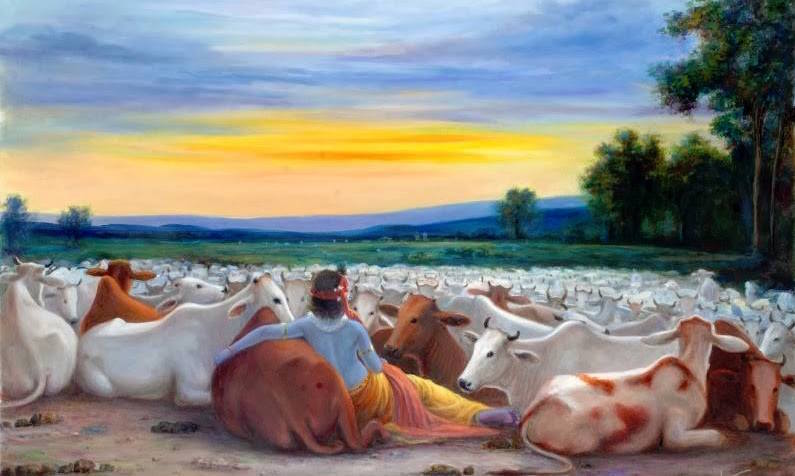 Such is the process of knowledge by which the cosmos becomes known and understood. To be sure, there is some congruence between the cosmos as understood through modern technology and that as presented in the Bhāgavatam. But the latter discloses the creation in relation to the creator, the cosmos as pervaded and animated by the Lord—īśāvāsyam idaṁ sarvam, as the first verse of the Īśopaniṣad puts it. And the cosmos, as perceive in that way, is itself pūrṇa, full, perfect and complete. “All forms of incompleteness,” Śrīla Prabhupāda comments, “are experienced due to incomplete knowledge of the Complete Whole.”
Such is the process of knowledge by which the cosmos becomes known and understood. To be sure, there is some congruence between the cosmos as understood through modern technology and that as presented in the Bhāgavatam. But the latter discloses the creation in relation to the creator, the cosmos as pervaded and animated by the Lord—īśāvāsyam idaṁ sarvam, as the first verse of the Īśopaniṣad puts it. And the cosmos, as perceive in that way, is itself pūrṇa, full, perfect and complete. “All forms of incompleteness,” Śrīla Prabhupāda comments, “are experienced due to incomplete knowledge of the Complete Whole.”
When you look at the model of that cosmos suspended beneath Rādhā-Kṛṣṇa under the dome of the Temple of the Vedic Planetarium, you may not recognize the cosmos as you think you know it. For that model is derived from that ultimate vision of everything as spiritual. In Śrīmad-Bhāgavatam 4.29.69, the yogic cosmonaut Nārada Muni himself discloses how one may attain that vision. He says,
“Kṛṣṇa consciousness means constantly associating with the Supreme Personality of Godhead in such a mental state that the devotee can observe the cosmic manifestation exactly as the Supreme Personality of Godhead does.”
Keeping one’s mind very close to Lord Kṛṣṇa, one may be able to see the phenomenal world in just the way that He does.
When, by our cooperative efforts worldwide, the Temple of the Vedic Planetarium is completed at the heart of ISKCON, all of its associated centers everywhere will become more fully manifest as entranceways to the spiritual world. This will be a major achievement—a crowning achievement—of Śrīla Prabhupāda’s project, following Śrīla Bhaktisiddhānta Sarasvatī Ṭhākura, of “the respiritualization of the entire human society,” empowering the whole world to “convert the illusory consciousness into Brahman.”
Gratitude to Yadubhara Prabhu, Shrisha Dasa, Sraddhadevi Dasi, and others for use of their photos.
“Morning, Looking East Over the Hudson Valley from the Catskill Mountains” painting by Frederic Edwin Church.
“World Highest Standard of Living” photo by Margaret Bourke-White.




Comments